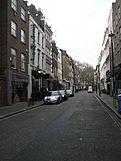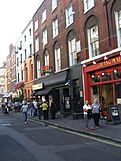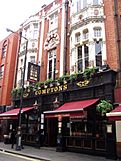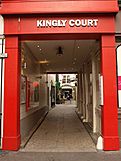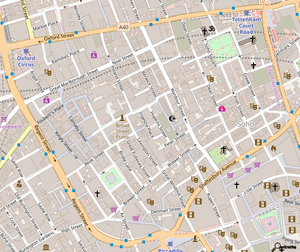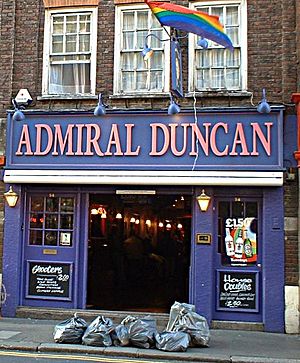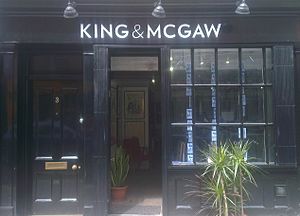Soho facts for kids
Soho is a lively area in the City of Westminster, part of the West End in London, England. It has been known for a long time as a fun place with lots of entertainment. Many big film companies also have their main offices here.
Since the 1980s, Soho has become more modern and fancy. It is now mostly known for its cool restaurants and offices for media companies. Soho is a small area in central London that welcomes people from many different backgrounds. It has businesses, shops, cultural spots, and entertainment. People from all walks of life live there too.
You can find many clubs, public houses, bars, and restaurants in Soho. There are also late-night coffee shops. These places make the streets feel busy "all night" on weekends. Shops that sell music records are mostly found around Berwick Street. Some popular ones are Phonica, Sister Ray, and Reckless Records.
On many weekends, Soho gets so busy that some streets are closed to cars. The Westminster City Council tried to make parts of Soho car-free in the 1990s. But they later changed it back. This was because local businesses said they were losing customers.
Contents
What Does "Soho" Mean?
The name "Soho" first appeared in the 1600s. Most experts believe it comes from an old hunting cry. For example, James Scott, 1st Duke of Monmouth, used "soho" as a call for his soldiers. This happened at the Battle of Sedgemoor in 1685. This was about 50 years after the name was first used for this part of London.
The name Soho has been copied by other fun areas around the world. These include Soho, Hong Kong; Soho in Málaga, Spain; SOHO in Beijing, China; and Palermo Soho in Buenos Aires, Argentina. SoHo, Manhattan in New York City also got its name from London's Soho. Its name means "SOuth of HOuston Street."
Where is Soho Located?
Soho covers about one square mile (2.5 square kilometers). Today, it is usually thought to be bordered by Oxford Street to the north. Regent Street is to the west, Leicester Square to the south, and Charing Cross Road to the east. However, most of these roads were built later. So, they are not Soho's original borders. Soho has never been an official area with fixed boundaries.
To the west of Soho is Mayfair. To the north is Fitzrovia. To the east are St Giles and Covent Garden. To the south is St James's. The Soho Society believes that Chinatown is part of Soho. Chinatown is between Leicester Square and Shaftesbury Avenue. But some people think it is a separate area.
Soho's Past
Early Days of Soho
In the Middle Ages, the area we now call Soho was farmland. It was known as Saint Giles Field. This land belonged to a convent and a hospital. In 1536, King Henry VIII took the land. He made it a royal park for his Palace of Whitehall.
In the 1660s, the King gave Soho Fields to Henry Jermyn, 1st Earl of St Albans. He rented out most of the land to Joseph Girle. Girle then passed his right to build to Richard Frith in 1677. Frith started building houses there. In 1698, King William III gave most of this land to William Bentinck, 1st Earl of Portland.
Soho never became a super fancy area for the very rich. Instead, many immigrants came to live there. Especially, French Huguenots arrived after 1688. Because of this, the area became known as London's French quarter. A French church was even built in Soho Square in the 1600s. By the mid-1700s, rich families had moved out of Soho. This is partly why Soho kept its unique character. It was not redeveloped like other rich areas nearby.
Soho's population grew very fast. By 1851, it had 327 people per acre. This made it one of London's most crowded places. Houses were split into many small apartments. This led to lots of people living in small spaces and many diseases. A bad outbreak of cholera in 1854 made the remaining rich families leave Soho. Many hospitals were built to help with health problems. Six hospitals were built between 1851 and 1874.
In the early 1900s, people from other countries opened affordable restaurants. Soho became a popular place for thinkers, writers, and artists to eat. Writers like Arthur Ransome wrote about Soho's coffee houses.
From the 1930s to the early 1960s, Soho's pubs were said to be full of writers and artists. Many pub owners became well-known during this time. A colorful painting on Broadwick Street shows famous Soho people. These include writer Dylan Thomas and jazz musician George Melly. In a famous story, Strange Case of Dr Jekyll and Mr Hyde, Dr. Henry Jekyll set up a home for Edward Hyde in Soho.
Soho was part of the old parish of St Martin in the Fields. As more people moved in, a new church was needed. In 1687, a new parish called St Anne was created. This parish covered all of eastern Soho, including the Chinatown area. The western part of modern Soho, around Carnaby Street, was part of the parish of St James.
The Broad Street Pump and Public Health
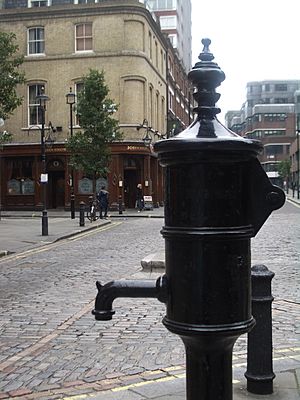
An important event in the history of public health happened in Soho. In 1854, there was a serious outbreak of cholera. Dr. John Snow studied this outbreak. He found that the cause was water from a public water pump. This pump was located at the corner of Broad Street (now Broadwick Street) and Cambridge Street (now Lexington Street).
John Snow drew a map of where sick people lived. He saw that most of them got their water from the Broad Street pump. He convinced the authorities to remove the pump's handle. This stopped people from getting more infected water. Later, it was found that the water source under the pump was dirty. This was an early example of using science to solve a real-life health problem.
Today, many buildings from 1854 on Broad Street have been replaced. Broad Street was even renamed Broadwick Street in 1936. The original pump is gone. But a copy of it with a small sign stands near the original spot. There is also a pub nearby called "The John Snow."
A copy of the pump, with a memorial sign and no handle, was put up near where the original pump stood. The missing handle reminds people of John Snow's action to stop the disease.
Soho's Restaurants
Many small and affordable restaurants and cafes opened in Soho in the 1800s. This was especially due to Greek and Italian immigrants. At first, these restaurants were not very popular. But their reputation changed in the early 1900s. In 1924, a guide said that Soho's inexpensive restaurants had become "extraordinarily popular."
Soho's Music Scene
Soho's music history goes back to 1948. That's when Club Eleven opened. It was one of the first places in the UK to play modern jazz, also known as bebop. The Harmony Inn was a popular spot for musicians in the 1940s and 1950s. It stayed open late and attracted jazz fans.
The 51 Club, a place for traditional jazz, opened in the early 1950s. Blues musician Cyril Davies and guitarist Bob Watson started the London Skiffle Centre in 1952. It was London's first skiffle club.
In the early 1950s, Soho became the center of the beatnik culture in London. Coffee bars like Le Macabre had coffin-shaped tables. They encouraged beat poetry, jive dancing, and political talks. The Goings On was a Sunday afternoon club for beat poets. Other "beat" coffee bars included the French, Le Grande, and the Moka Bar.
The 2i's Coffee Bar opened in 1956. It was likely the first rock club in Europe. Soon, Soho was the heart of London's new rock music scene. Other clubs included the Flamingo Club and Whisky a Go Go. Jazz clubs like Ronnie Scott's also opened. Ronnie Scott's opened in 1959 and moved to Frith Street in 1965.
Soho's Wardour Street was home to the Marquee Club. It opened in 1958. The Rolling Stones first played there in July 1962. Eric Clapton and Brian Jones even lived in Soho for a while.
Soho was also home to Trident Studios from 1968 to 1981. Famous artists recorded there, including The Beatles, The Who, Elton John, Queen, and David Bowie.
Although not technically in Soho, Denmark Street is famous for its music connections. It is called the British Tin Pan Alley. This is because it has many shops selling musical instruments. The Sex Pistols lived and recorded their first songs there. Jimi Hendrix, the Rolling Stones, and Donovan also recorded there. Elton John wrote his hit song "Your Song" on this street. Gerrard Street in Soho is where Led Zeppelin first practiced together in 1968.
Recent Times in Soho
In 2006, a campaign called I Love Soho started. Its goal was to bring more business back to Soho. The campaign had a website and was launched with celebrities like Charlotte Church and Amy Winehouse. I Love Soho was supported by the former Mayor of London Ken Livingstone and other groups.
Famous Places in Soho
Soho Streets
Here are some well-known streets in Soho:
- Berwick Street has record shops, fabric shops, and a small street market. The market is open from Monday to Saturday.
- Carnaby Street was a fashion center in the 1960s. It was known as "Swinging London."
- D'Arblay Street has The George pub and The Breakfast Club Cafe.
- Dean Street is home to the Soho Theatre. It also has a pub called The French House. This pub was popular with the French government during World War II. Karl Marx lived on Dean Street from 1851 to 1856.
- Denmark Street was a music publishing hub. It has many musical instrument stores.
- Frith Street is where John Logie Baird first showed television. A sign above the Prince Edward Theatre shows where Mozart lived as a child.
- Gerrard Street was home to Ronnie Scott's Jazz Club. It is now the center of London's Chinatown.
- Golden Square is a garden square. Many big media companies are located here.
- Great Marlborough Street was once where Philip Morris had his first London factory. It gave its name to the Marlboro cigarettes. It was also home to the London College of Music.
- Great Windmill Street was home to the Windmill Theatre. The ideas for The Communist Manifesto were discussed at a meeting in the Red Lion pub here.
- Greek Street is famous for its restaurants.
- Old Compton Street was where Europe's first rock club, 2i's club, started. Dougie Millings, the famous tailor for The Beatles, had his first shop here. Old Compton Street is now the main area for London's gay community.
- In Soho Square are Paul McCartney's office and the former headquarters of The Football Association.
- Wardour Street was home to the Marquee Club. Another rock hangout was The Intrepid Fox pub.
The Windmill Theatre
The Windmill Theatre was open from June 1931 to October 1964. It claimed it "Never Closed" during World War II. (It was actually closed for 12 days in September 1939). The theatre was built on the site of an old windmill. This windmill gave its name to the street.
Soho's Culture
Soho is very close to London's theatre area. It has the Soho Theatre, which opened in 2000. It shows new plays and comedy. Gerrard Street is the heart of London's Chinatown. It has many import companies and restaurants. The song "Pinball Wizard" by The Who mentions Soho. Street festivals happen all year, especially for the Chinese New Year.
Soho is a hub for independent film and video. It is also a center for TV and film post-production. The British Board of Film Classification is in Soho Square. This board decides how movies are rated. Soho's main fiber network is managed by Sohonet. It connects Soho's media companies to film studios like Pinewood Studios and Shepperton Studios. It also connects to other big production centers worldwide.
Soho Radio started broadcasting live on May 7, 2014. It is on Great Windmill Street. Soho Radio broadcasts 24 hours a day. It also has a shop and coffee place. The station says it wants to "reflect the culture of Soho."
Soho has many religious groups. These include St Anne's Church on Dean Street. It was damaged in World War II but reopened in 1990. The Church of Our Lady of the Assumption and St Gregory is on Warwick Street. St Patrick's Church in Soho Square was founded by Irish immigrants. There is also a Hare Krishna Temple and a small mosque. The French Protestant Church of London is also in Soho.
Getting Around Soho
The closest London Underground stations are Oxford Circus, Piccadilly Circus, Tottenham Court Road, Leicester Square, and Covent Garden.
Westminster Council has noted that the narrow sidewalks can get very crowded at night. This is especially true on weekends. People eat outside, wait in line for entertainment, or use ATMs. This can sometimes cause small problems between people walking and traffic.
Images for kids
-
A blue plaque at the site of the Marquee Club on Wardour Street, Soho, remembering Keith Moon of The Who
See also
 In Spanish: Soho (Londres) para niños
In Spanish: Soho (Londres) para niños


